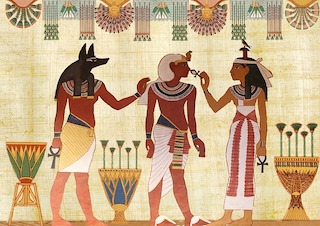



|
|
|
|
|
|
|
|
|
|
|
|
|
|
|
|
|
|
|
|
|
|
|
|
|
|
 The history of essential oils is intertwined with the history of herbal medicine, which in turn has been an integral part of magical practices. Herbal medicine has been used for more than treating minor ailments and disease; it has been instrumental in providing life-enhancing benefits. In most ancient cultures, people believed plants to be magical, and for thousands of years, herbs were used as much for ritual as they were for medicine and food. According to medical herbalist and healer Andrew Chevallier, the presence of herbs in burial tombs attests to their powers beyond medicine. In addition, fourth-century BCE Greek philosopher Aristotle noted his belief that plants had psyches.
The history of essential oils is intertwined with the history of herbal medicine, which in turn has been an integral part of magical practices. Herbal medicine has been used for more than treating minor ailments and disease; it has been instrumental in providing life-enhancing benefits. In most ancient cultures, people believed plants to be magical, and for thousands of years, herbs were used as much for ritual as they were for medicine and food. According to medical herbalist and healer Andrew Chevallier, the presence of herbs in burial tombs attests to their powers beyond medicine. In addition, fourth-century BCE Greek philosopher Aristotle noted his belief that plants had psyches.
Aromatic plants in the form of oil and incense were elements of religious and therapeutic practices in early cultures worldwide. In addition, anointment with perfumes and fragrant oils was an almost universal practice. Burning incense in rituals provided a connection between the physical and spiritual—between the mundane and the divine. It was a common belief that contact with the divine could be achieved through the smoke of incense.

The ancient Egyptians believed that deities were embodied in the smoke and fragrance of temple incense. In addition, aromatics were used to deepen meditation and purify the spirit as well as to add subtlety to their sophisticated system of magic. Dating to approximately 1500 BCE, the Ebers papyrus is the oldest written record of Egyptian use of medicinal plants. Along with the physical details of plants, the manuscript contains related spells and incantations. It also mentions fine oils for perfumery and incense. Made from healing herbs, many of the perfumed oils doubled as medicines. Likewise, Egyptian priests often doubled as physicians and perfumers. Those who specialized in embalming the dead also used their expertise for the living by creating mixtures to beautify skin and protect it from the harsh, damaging desert climate.
The Babylonians also employed the use of aromatic plants and became a major supplier of plant materials to other countries. Both the Babylonians and Sumerians prized cedarwood, cypress, myrtle, and pine for their deities. The Assyrians were fond of aromatics for religious rituals as well as personal use, and the Mesopotamians used ceremonies and special incantations when gathering herbs. In the thirteenth century BCE, the Mycenaeans used scented oils to honor deities. Throughout the ancient world, there was a thriving trade in herbs, spices, and oils among Europe, the Middle East, India, and Asia.
Some of the earliest writings from India, known as the Vedas (circa 1500 BCE), contain praises to the natural world along with information about aromatics including cinnamon, coriander, ginger, myrrh, sandalwood, and spikenard. Working with herbs was, and still is to a certain degree, considered a sacred task in India. This eventually evolved into Ayurvedic medicine, which is believed to be the oldest system of healing. Written by the physician Charaka in 700 BCE, the Charaka Samhita details approximately 350 plants and is still widely consulted today. In addition to healing, oils play an important role in the religious rites of India. Anointing with perfumed oils is used to purge worshippers of spiritual impurities. Although the tenth-century Middle Eastern physician Avicenna (980–1037) is often credited with discovering the distillation process, archaeological evidence from the Indus Valley in northern India indicates that distilling aromatic plants into oils was achieved there around 3000 BCE.
Herbs are also integral to traditional Chinese medicine, which dates to approximately 200 BCE in a text called the Yellow Emperor’s Classic of Internal Medicine. Herbs were also important for maintaining beauty and hygiene. Chinese herbalists influenced the practices of Japan and Korea, as fifth-century Buddhist monks transported spiritual and medicinal information with them on their travels. There was also movement westward as Phoenician merchants traded scented oils around the Mediterranean region, bringing aromatic treasures from the East to Europe—most notably to the Greeks and Romans. Greek physician and botanist Pedanius Dioscorides (circa 40–90 CE) compiled the first herbal manuscript in Europe, De Materia Medica, which served as a major reference well into the seventeenth century. The ancient Romans carried on the Greek use of botanicals for medicinal and perfumery purposes.
Shopping Basket
| Items: | 0 |
| Subtotal: | $0.00 |
Standard Shipping within the US on All Orders
- All Natural
- Hypoallergenic
- Use Essential Oils
- Effective
- Paraben Free
- Phthalate Free
- Alcohol Free
- Mineral Oil Free



